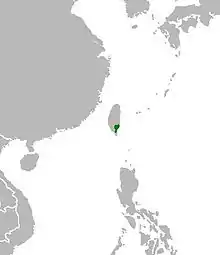Podocarpus costalis
Podocarpus costalis, locally known as arius,[2] is a species of conifer in the family Podocarpaceae. It is native to the Philippines and Taiwan.[1]
| Podocarpus costalis | |
|---|---|
-1.jpg.webp) | |
| Scientific classification | |
| Kingdom: | Plantae |
| Clade: | Tracheophytes |
| Division: | Pinophyta |
| Class: | Pinopsida |
| Order: | Pinales |
| Family: | Podocarpaceae |
| Genus: | Podocarpus |
| Species: | P. costalis |
| Binomial name | |
| Podocarpus costalis C.Presl | |

This plant grows in island scrub, low forest, or in a limestone bluff or sea stack habitat, growing at elevations from sea level to nearly 300 meters.[3] It is also widely cultivated as a garden plant.[1] It is used in bonsai.[1] The fruit is edible.[2]
One threat to the survival of wild populations is overcollecting for horticulture; this practice is illegal throughout its native range.[1]
Description
Podocarpus costalis is a small, shrubby tree, usually ranging from one to five meters high. It has bud of foliage two to four millimeters long. The plant it is often confused with P. polystachyus because of the similar habitats and leaves.[4]
Conservation
The plant is endangered largely on account of its minuscule area of occupancy of about 24 square kilometers. It is limited to five islands and localities, and its growth is naturally limited to a specific habitat. It has also become endangered because of continual removal of mature plants for horticulture or as potted plants, depleting its population. The plants have been taken from the wild to be planted in gardens in Luzon and Taiwan, only increasing the rate of removal.
Countries with the plant natively have legally protected it, with countries such as the Philippines and Taiwan making the collection of the plant from the wild illegal. Those interested in the plant have been advised to grow the plant by seed to avoid removing any more of the plants from their natural habitat.[5]
References
| Wikimedia Commons has media related to Podocarpus costalis. |
- Carter, G. & Farjon, A. 2013. Podocarpus costalis. Archived 2016-04-18 at the Wayback Machine The IUCN Red List of Threatened Species. Version 2015.2. Downloaded on 03 September 2015.
- dela Cruz, R. Potential food products from "Batanes berries" explored. Archived 2015-08-28 at the Wayback Machine BAR Chronicle. Bureau of Agricultural Research, Philippines. June, 2012.
- Farjon, Aljos; Filer, Denis (2013-11-15). An Atlas of the World's Conifers: An Analysis of their Distribution, Biogeography, Diversity and Conservation Status. BRILL. ISBN 9789004211810.
- Earle, Christopher (28 February 2019). "Podocarpus costalis". The Gymnosperm Database. Archived from the original on 11 April 2019. Retrieved 6 June 2019.
- Carter, G.; Farjon, A. (7 September 2015). "Prodocarpus costalis". Threatened conifers of the world. Archived from the original on 5 May 2018. Retrieved 6 June 2019.
